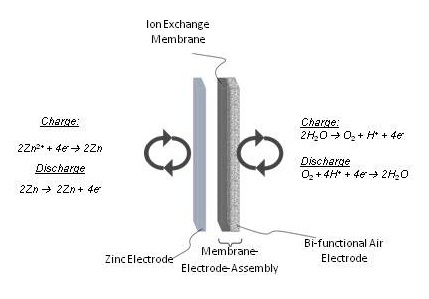Zinc / Air Redox Flow Battery
Redox flow batteries are a relatively new technology to store large quantities of energy. Such a system increases the flexibility, minimizes the environmental risk and improves the response time to a demand. Rather than having the electroactive materials being stored inside the cell housing of the battery, and being limited to the volume of the secondary battery, in redox flow batteries the electroyte can be circulated into and out of a reservoir tank. The tank volume gives the extent of energy storage. In this way complete freedom is generated in terms of energy storage (Wh) and power generation (W). Figure 1 depicts the schematics of an all vanadium redox flow battery system.
So far, redox flow batteries were always developed for stationary applications since the specific energy (Wh/kg) of the existing redox flow batteries is too low to be of any meaning for mobile applications. The reason is that for the commercially available redox flow batteries always two solutions are needed. Current development of energy storage systems like Li-ion and NiMH batteries have led to much larger values for the specific energy namely in the order of 200 Wh/kg for Li-ion batteries. Although the specific energy of these Li-ion systems has now reached the long term goal of the United States Advanced Battery Consortium (USABC), a large market introduction for electric vehicles has not yet been realized due to several remaining challenges. Due to that a new system in which the weight reduction has been achieved by replacing one liquid redox couple by an omnipresent gaseous redox couple has been developed and described in the literature by Hosseiny et al. [17]. However, although this system could achieve twice as high specific energy density values compared to the all vanadium redox flow battery major disadvantages such as the oxygen sensitivity of the vanadium redox couples reduced the efficiency of the system. In this work we are engaged in the development of a zinc/air redox flow battery with novel solvent system in which we replace the air sensitive vanadium redox couple by zinc.
 All Vanadium Redox Flow Battery
All Vanadium Redox Flow Battery
|
Current Research
Zinc air batteries, also known as zinc air fuel cells require highly concentrated sodium or potassium hydroxide as an electrolyte. This leads to many issues among them:
- Air electrode clogging due to carbonate formation in contact with CO2
- Zincoxide formation and highly viscose electrolyte
- Membrane instability and degradation
These issues are mainly due to the high hydroxyl containing electrolytes. Yet, the commercialized zinc air batteries are of a primary nature. This means, that either the battery or the zinc has to be replaced once the battery is discharged. However, also the development of the electrically rechargeable zinc air battery faces the above mentioned issues as well other such as appropriate bi-functional air electrodes, OH- depletion during discharge and zinc dendrite formation. To overcome these issues we are focusing the development of a rechargeable zinc air redox flow battery in with a new type of solvent system. The described system will have a theoretical open circuit potential of 1.73 V at pH 9.
The following figure depicts the medium alkaline zinc air redox flow battery with novel solvent system and the reactions occurring during charge and discharge.
 Schematic of the new zinc air redox flow battery with novel solvent system and the reactions occurring during
charge and discharge cycles.
Schematic of the new zinc air redox flow battery with novel solvent system and the reactions occurring during
charge and discharge cycles.
|
This work includes, apart from the battery development also:
- The creation of novel light weight bi-functional air electrodes
- Development and characterization of the solvent system
- Design of stable and highly conductive membrane electrode assemblies
